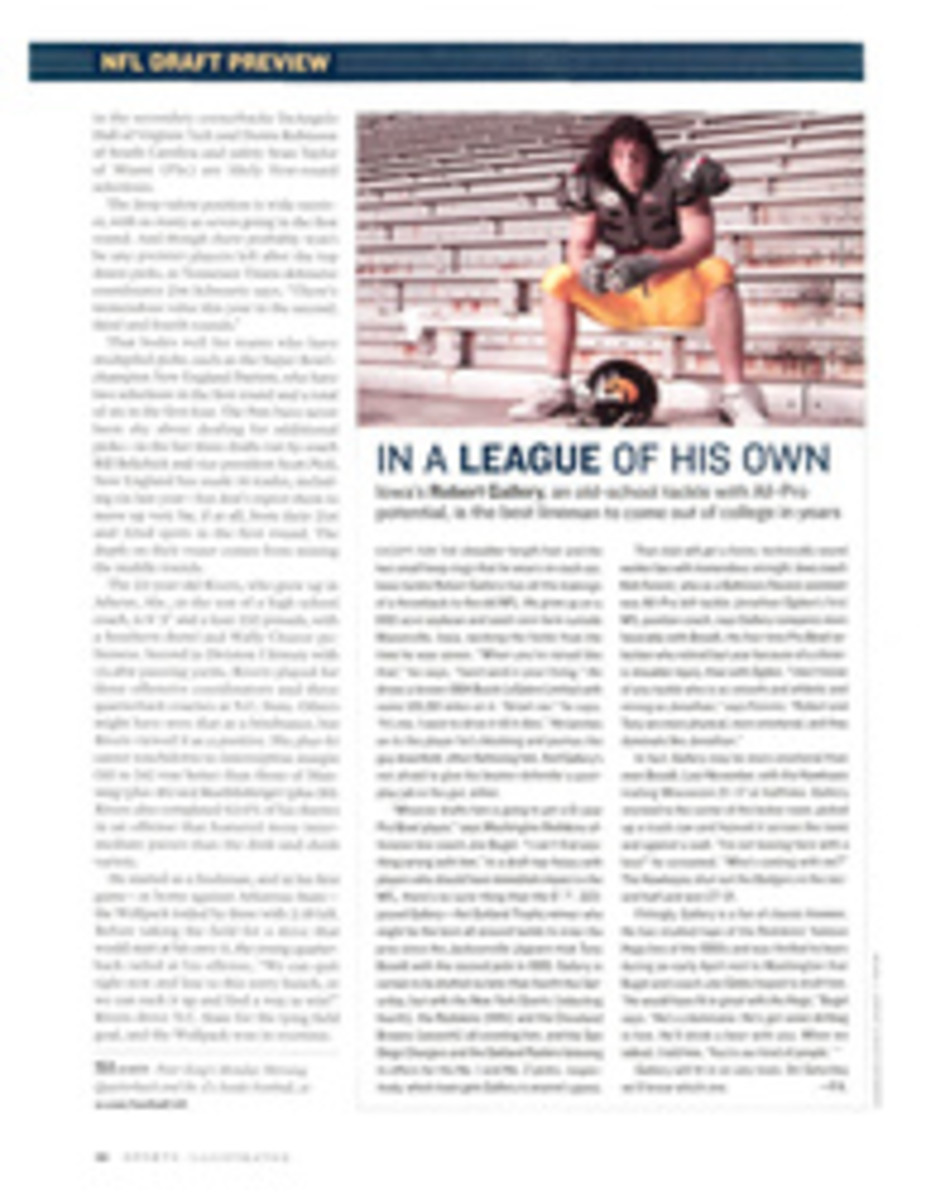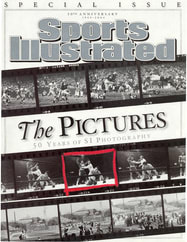
Crack of the Bat, and the Bindings April always brings a shower of new baseball books--here are five of note this spring
BABE RUTH: LAUNCHING THE LEGEND
By Jim Reisler
McGraw-Hill $24.95 274 pages
HANK AARON AND THE HOME RUN THAT CHANGED AMERICA
By Tom Stanton
William Morrow $23.95 245 pages
The two most prolific home run hitters in major league
history--so far--are celebrated in these two quite different but
equally engaging books. They're different, of course, because,
prodigious homer hitting aside, Babe Ruth and Hank Aaron have
about as much in common as Henry VIII and Jimmy Carter. The
Babe's idea of a hearty breakfast, writes baseball historian Jim
Reisler, was "a pint of bourbon and a bottle of ginger ale, a
porterhouse steak, four eggs, a double order of fried potatoes,
toast and a pot of coffee, followed by a king-sized cigar."
Aaron, according to Tom Stanton, a former newspaper editor, "was
a man of moderation who ... took care of himself, getting plenty
of rest, exercising in the off-season and eating light on game
days." Both books describe pivotal moments in baseball history:
Ruth's record-smashing debut as a New York Yankee in the fateful
year 1920, and Aaron's successful pursuit of the Babe's career
home run record through 1973 to the Atlanta Braves' home opener
in '74.
Even without Ruth, the '20 season would have been memorable,
witnessing as it did the game's only fatal beaning (Cleveland
shortstop Ray Chapman by the Yankees' Carl Mays), the revelations
of the infamous 1919 World Series fix and the subsequent hiring
of the game's first commissioner, the dictatorial Kenesaw
Mountain Landis. But these momentous events were overshadowed by
Ruth's "unthinkable, unimaginable, unfathomable and downright
scary" performance that year. His 54 homers surpassed his own
record of the previous season by 25. His total was nearly three
times that of his nearest competitor (George Sisler, with 19) and
higher than that of all but one other team, the Phillies, in
either league. In hitting 54, he not only rescued the game from
tragedy and scandal but changed it forever from a "scientific,"
low-scoring chess match to the swing-for-the-fences slugfest it
remains today.
Much of the material covers the same ground as Robert Creamer's
epic Ruth biography, Babe, but in narrowing his focus to this one
breakthrough season, Reisler casts a new and welcome light on the
sudden, tremendous impact Ruth had on his game--and all of
American sports.
Despite the boast in Stanton's title, Aaron's 715th home run
didn't effect nearly as much change. True, it was hit by a black
man in a Southern city, but that feat hardly eradicated racism
and did not alter the way the game is played. The real story
here, as in Aaron's 1991 autobiography I Had a Hammer, is of the
trials this wondrous player endured on the way to his big moment.
Aaron suffered with dignity merciless racial taunts from the
stands, the perceived indifference of Atlanta fans and civic
officials to his accomplishments, despicable hate mail and,
finally, repeated death threats.
This is not to mention unfair comparisons with his more glamorous
predecessor, including this curious one from Ruth's widow,
Claire, in 1973: "Lindbergh was the first man to fly nonstop
across the Atlantic. Nobody remembers who was the second or the
third. So it is with the Babe." She was wrong, of course. Aaron
is remembered. And so, 30 years later, is his record. Chances are
we'll hear a lot more about it as a new and controversial
challenger, Barry Bonds, closes in on it.
For all of the quotidian detail in these pages, however, the book
curiously lacks Aaron's own observations today on his long-ago
ordeal. Since, unlike Ruth, the man is very much alive, it would
have been nice to hear from him. --Ron Fimrite
THE TICKET OUT: DARRYL STRAWBERRY AND THE BOYS OF CRENSHAW
By Michael Sokolove
Simon & Schuster $24.95, 291 pages
Even a decade ago, Darryl Strawberry had already broken more
hearts than Mae West. Since then, whether busting out of rehab or
propositioning an undercover policewoman, the wayward slugger has
kept up a steady flow of teary-eyed confessions ("The reason I
haven't killed myself is my five children....") and empty vows to
sin no more ("I only have to answer to myself, my family and my
God"). You can't be blamed if you're sick of him. But you still
might want to read this book. It doesn't defend Strawberry, but
it does take a sobering look at where he came from and how that
contributed to his makeup.
Sokolove, a contributing writer for The New York Times Magazine,
chronicles the 1979 Crenshaw High Cougars, one of the best high
school teams ever. Though the most famous alums from that year
were Strawberry and future All-Star Chris Brown, virtually every
starter was a pro prospect, a rare blast of hope amid the
poverty, violence and despair of South Central L.A.
But the guys from Crenshaw met with so much ill fortune, you
wonder if maybe the Bambino cursed them, too. Shortly before the
city-championship game against Granada Hills, the team's
dedicated but high-strung coach, Brooks Hurst, was whacked in the
face by a practice throw, and his jaw had to be wired shut.
Nonetheless, Crenshaw seemed to have a good shot at winning until
Granada Hills brought in a relief pitcher--John Elway.
Strawberry's teammates seem, for the most part, much more complex
and interesting than he is. All his life, the star's screwups
would be forgiven, but for most of the other players, the
opposite was true: A single bad choice could destroy their dream.
A violent outburst got talented pitcher Donald Jones thrown out
of high school, and he turned to drugs. Cordie Dillard and Darryl
McNealy were drafted by the San Francisco Giants, but while
playing minor league ball in Montana they stole a credit card and
went on a shopping spree. Both were thrown out of baseball.
What really enrages Sokolove is the fate of Carl Jones, whom the
author describes as the "straight-talking, dirty-uniformed,
clutch-hitting catcher" on the Cougars. The same justice system
that has given Strawberry unlimited chances has declared Jones, a
cocaine addict, unsalvageable. Though he has never committed a
violent crime, Jones has been found guilty of three nonviolent
ones, and under California's "three strikes and you're out" law,
he'll be in jail until he's almost 60. Three strikes and you're
out "doesn't even hold up as a baseball metaphor," Sokolove
fumes. "Baseball is a sport of forgiveness and opportunity. Your
turn in the lineup keeps coming around." The Ticket Out raises
some serious questions about the meaning of fair play. --Charles
Hirshberg
THE LAST BEST LEAGUE: ONE SUMMER, ONE SEASON, ONE DREAM
by Jim Collins Da Capo Press, $24 269 pages
It's been said that if reporters were allowed to choose their own
assignments, newspapers would consist mostly of travelogues,
sports coverage and restaurant reviews. Jim Collins, former
editor of Yankee magazine, hasn't done much to defy that
stereotype, assigning himself to summer duty on the spectacular
Massachusetts seacoast to cover the Cape Cod Baseball League.
Collins embedded himself with the 2002 Chatham A's, and his book
chronicles the coming-of-age dramas of a dozen dreamy-eyed
prospects. If you're in the mood for one of those
baseball-as-allegory-and-tone-poem books, this one is better than
most. The writing is overwrought on occasion--"supple leather
batting gloves" grip "thick, solid" maple bat handles, and
ringing hits pierce "leafy canopies" of trees. Meanwhile, though,
"the smell of freshly cut grass, pine tar and Coppertone" wafts
across the field--"pure baseball," Collins writes, "the essence
of summer." So's the book. --C.H.
THE BASES WERE LOADED (AND SO WAS I)
by Tom Callahan
Crown Publishers $24.95 230 pages
Tom Callahan spends the pages of this unabashed memoir popping
up, Zelig-like, at historically significant moments to mingle
with the mighty, from Pete Rose to Sonny Liston, Oscar Robertson
to Steve Cauthen. "Every sportswriter ... practices participatory
journalism," Callahan writes in the preface. "It may be the
boxer's or the infielder's story he is telling, but the places
his stream crosses theirs are unique to him."
The gamble Callahan, a former TIME writer, undertakes is to
deliver his narrative with his own personality relentlessly in
the foreground. When his inside access amplifies his subjects,
Callahan excels. He recalls a conversation with Rose and New York
Times columnist Dave Anderson, as Rose chased Ty Cobb's hit
record. Asked how much he knew about Cobb, the manic, obsessive
Rose replied, "Everything about him but the size of his" private
parts. For the Times, Anderson bowdlerized the quote, as "the
size of his hat." The next day a livid Rose greeted Callahan,
shouting, "Seven and five f------eighths! Seven and five
f------eighths!" In another fascinating episode, an unglued
Robertson pounds a locker room urinal after a loss, then slumps
to the floor and tells Callahan, painfully and defiantly, of his
adolescence in Jim Crow Indianapolis.
Self occasionally stands in for substance here; some of the
anecdotes offered matter little except that they happened to
Callahan. The reader will learn that Johnny Bench believed
Callahan had had an affair with his wife, Vickie, "which, alas,
wasn't true," Callahan writes. "I will admit that I held her once
while she cried." He also informs us that he once slept with a
B-movie actress while working as a 16-year-old stagehand in a
summer theater company in Baltimore. Still, these are forgivable
indulgences of a memoirist establishing himself as protagonist.
Callahan tells a good yarn, and he doesn't hesitate to remind you
that he's the one telling it. --Daniel G. Habib
COLOR PHOTO: MCGRAW-HILL (RUTH)
COLOR PHOTO: WILLIAM MORROW (AARON)
COLOR PHOTO: SIMON & SCHUSTER
COLOR PHOTO: DA CAPO PRESS (CAPE COD)
COLOR PHOTO: CROWN PUBLISHING GROUP

